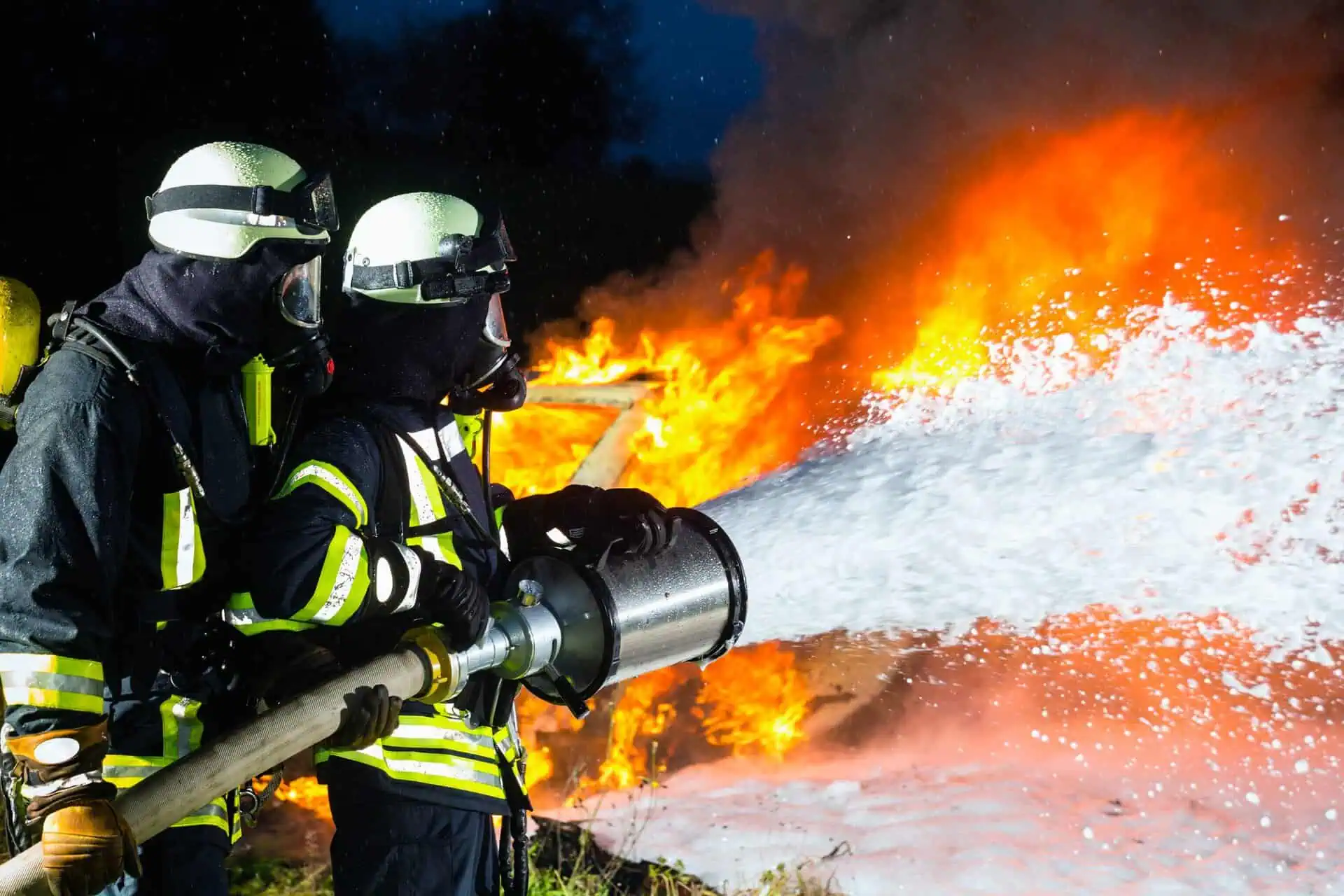AFFF Foam Cancer Lawsuit: Legal Implications
- Last Updated: June 12th, 2025

Attorney Jessica Paluch-Hoerman, founder of TruLaw, has over 28 years of experience as a personal injury and mass tort attorney, and previously worked as an international tax attorney at Deloitte. Jessie collaborates with attorneys nationwide — enabling her to share reliable, up-to-date legal information with our readers.
Legally Reviewed
This article has been written and reviewed for legal accuracy and clarity by the team of writers and legal experts at TruLaw and is as accurate as possible. This content should not be taken as legal advice from an attorney. If you would like to learn more about our owner and experienced injury lawyer, Jessie Paluch, you can do so here.
Fact-Checked
TruLaw does everything possible to make sure the information in this article is up to date and accurate. If you need specific legal advice about your case, contact us by using the chat on the bottom of this page. This article should not be taken as advice from an attorney.
Key takeaways:
- AFFF foam cancer lawsuits are legal actions taken by individuals who have developed cancer due to exposure to harmful chemicals, particularly PFAS, found in AFFF firefighting foam.
- Firefighters, military personnel, and airport workers who have been diagnosed with cancers such as kidney or testicular cancer and have a history of exposure to AFFF foam may be eligible to file an AFFF lawsuit.
- The future outlook for AFFF foam cancer lawsuits includes an expected increase in lawsuits, higher settlement payouts, and potential regulatory changes to minimize health and environmental risks associated with AFFF firefighting foam.
Overview of the AFFF Foam Cancer Lawsuit
On this page, we’ll discuss an overview of AFFF Foam Cancer Lawsuit, health risks associated with AFFF firefighting foam, how to file a claim in the AFFF lawsuit, and much more.
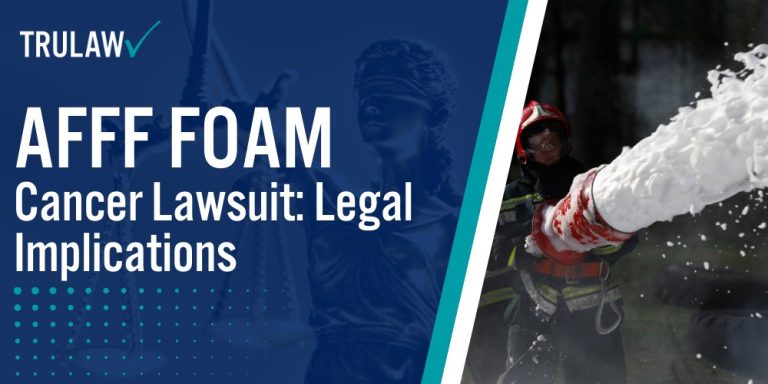
Intro to AFFF Foam Cancer Lawsuit
Key points about AFFF lawsuits:
- Manufacturers and Defendants: Major companies like 3M, Dupont, and Chemours have been named in lawsuits.
- Health Risks: Exposure to PFAS in AFFF foam has been linked to cancers such as kidney and testicular cancer.
- Affected Groups: Firefighters, military personnel, and workers in facilities using AFFF foam are at higher risk.
- Environmental Impact: AFFF contamination affects both water supplies and wildlife.
If you or a loved one has been exposed to PFAS chemicals in AFFF foam and later diagnosed with cancer, you may qualify to pursue compensation.
Contact TruLaw using the chat on this page to receive an instant case evaluation and determine if you are eligible to file an AFFF cancer lawsuit.
Table of Contents
AFFF Firefighting Foam and Its Risks
Aqueous film-forming foam (AFFF) is commonly used in firefighting to combat liquid fuel fires but contains harmful chemicals that pose significant health risks, including cancer.
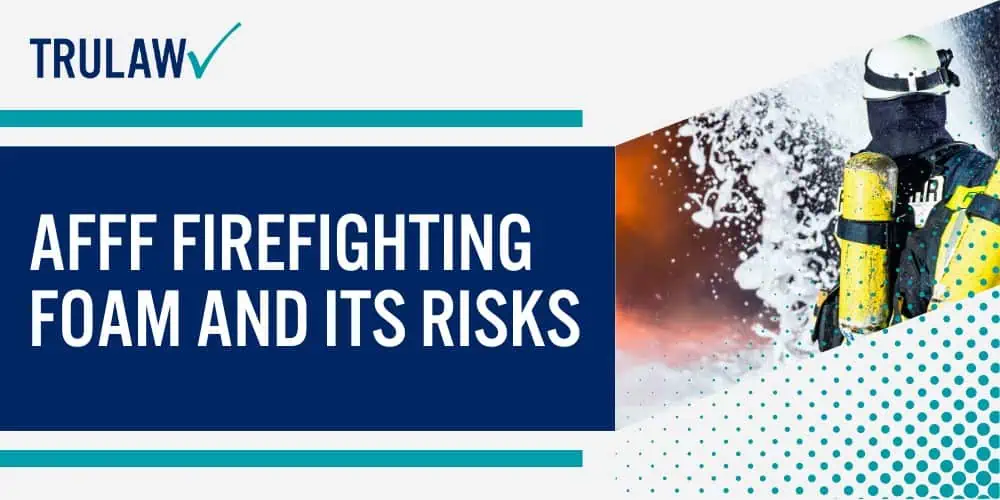
What Is AFFF Foam? Basics and Usage in Firefighting
AFFF foam, or aqueous film-forming foam, is a type of firefighting foam used to suppress fires caused by flammable liquids.
These foams are especially effective in creating a barrier that cools the fire and prevents oxygen from fueling it.
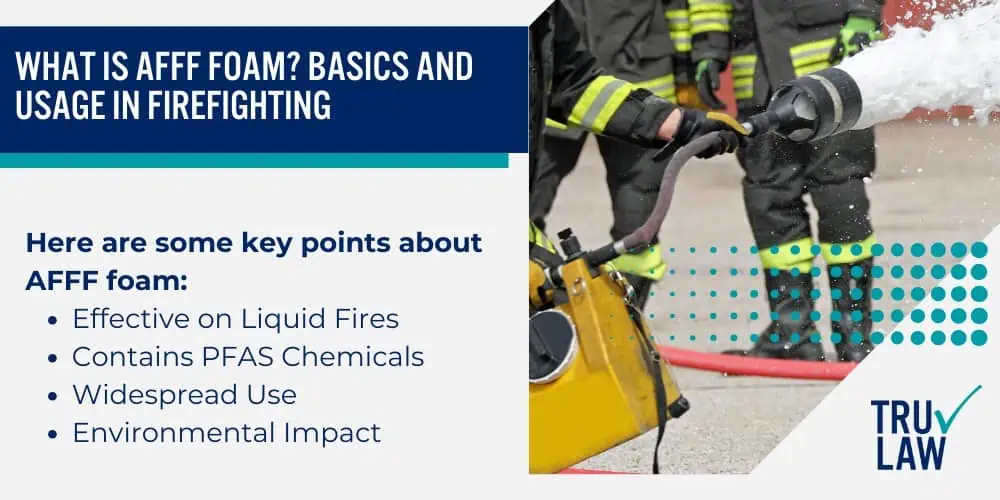
Here are some key points about AFFF foam:
- Effective on Liquid Fires: Primarily used for gasoline, oil, and other flammable liquids.
- Contains PFAS Chemicals: This category includes perfluoroalkyl and polyfluoroalkyl substances (PFAS), which are also known as “forever chemicals.”
- Widespread Use: Employed by the military, airports, and local fire departments.
- Environmental Impact: Known to contaminate water sources and soil.
Despite its efficiency in firefighting, the composition of AFFF foam raises concerns due to its long-lasting environmental effects and potential health risks.
Health Risks and Cancer Links Associated With AFFF Foam
AFFF exposure is linked to several health issues, primarily due to the PFAS chemicals present in the foam.
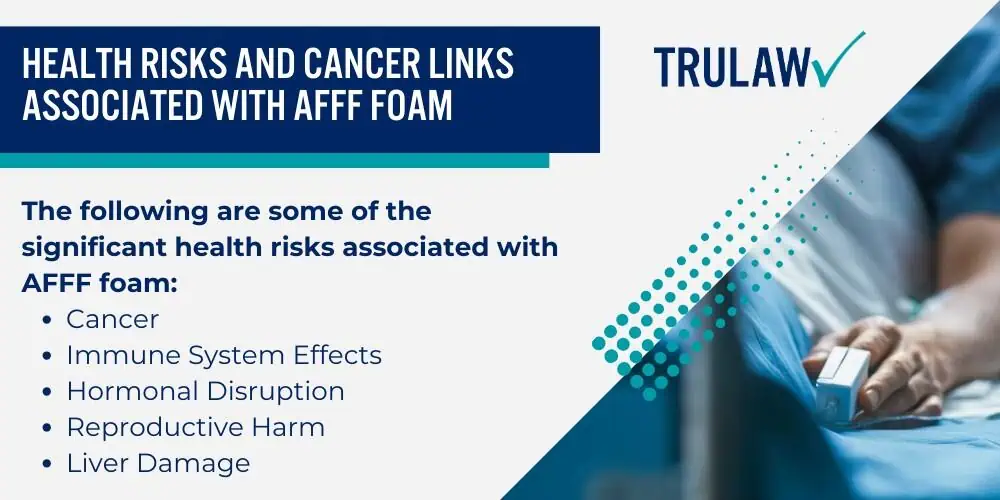
PFAS chemicals are known for their persistence in the environment and the human body, leading to their nickname, “forever chemicals“.
The following are some of the significant health risks associated with AFFF foam:
- Cancer: Studies have linked exposure to PFAS in AFFF foam to various cancers, including kidney and testicular cancer.
- Immune System Effects: Potential weakening of the immune system over time.
- Hormonal Disruption: Some PFAS can interfere with hormonal functions.
- Reproductive Harm: Linked to developmental issues in fetuses and young children.
- Liver Damage: Prolonged exposure can damage the liver.
This array of health concerns highlights the dangers of toxic firefighting foam and emphasizes the need for caution and regulation in its use.
The ongoing legislative efforts, like the Ohio AFFF Takeback Program, aim to minimize these risks by collecting and safely disposing of stockpiled AFFF foam.
Legal Landscape of AFFF Foam Cancer Lawsuits
The legal landscape for AFFF foam cancer lawsuits is complex and involves several key players.
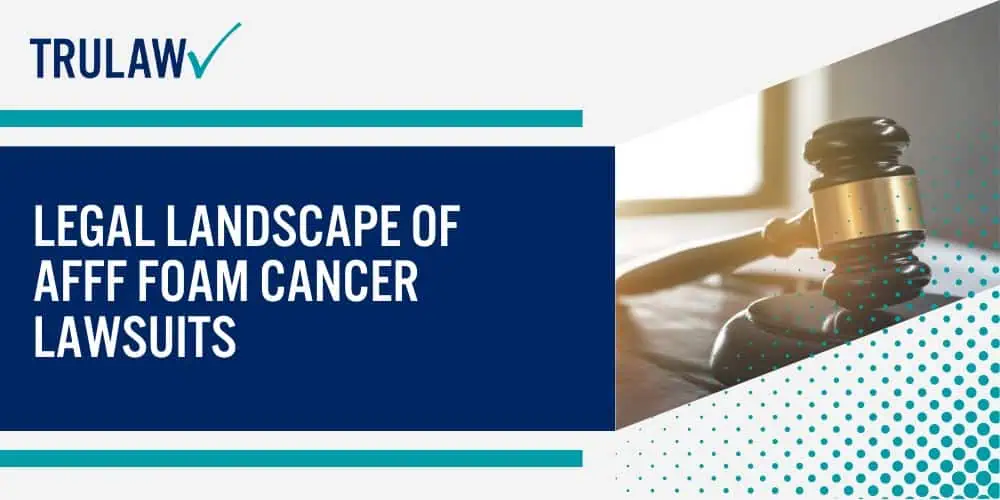
This section will cover the history and background of these lawsuits, major companies and specific lawsuits, and the importance of understanding the legal implications.
History and Background of AFFF Foam Litigation
AFFF, or Aqueous Film Forming Foam, has been used for decades, primarily by firefighters and the military.
Concerns arose when it was discovered that AFFF contained PFAS, chemicals linked to cancer.
Legal action began to surface as more instances of contamination were identified.
The lawsuits mainly address the environmental and health impacts of PFAS, which are known as “forever chemicals” due to their persistence in the environment and the human body.
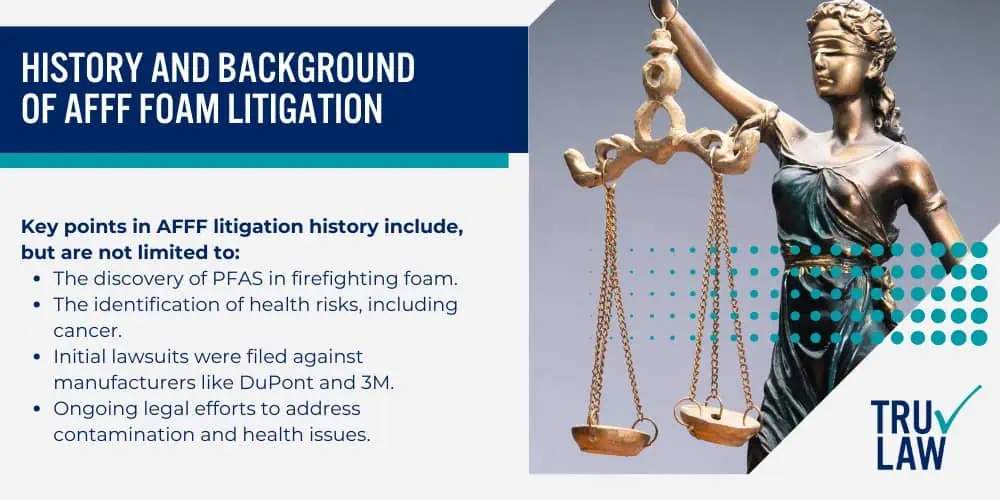
Key points in AFFF litigation history include, but are not limited to:
- The discovery of PFAS in firefighting foam.
- The identification of health risks, including cancer.
- Initial lawsuits were filed against manufacturers like DuPont and 3M.
- Ongoing legal efforts to address contamination and health issues.
Major Players and Key Lawsuits Involving AFFF Foam
Several major players are involved in AFFF foam litigation.
Companies like DuPont, 3M, and Chemours have been targeted for their role in manufacturing AFFF.
They face numerous lawsuits from states and individuals affected by PFAS contamination.
One significant case includes the Maryland lawsuit against 3M and others for contamination in the state’s water and natural resources.
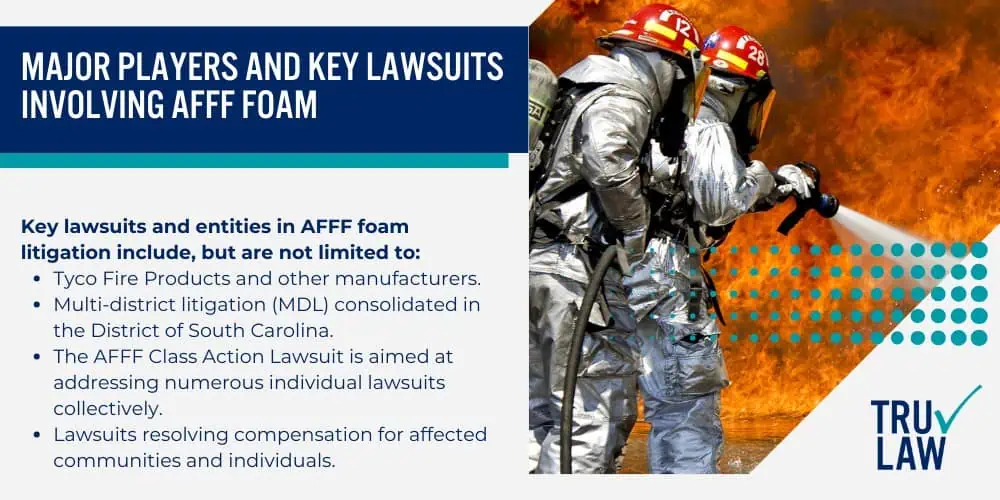
Key lawsuits and entities in AFFF foam litigation include, but are not limited to:
- Tyco Fire Products and other manufacturers.
- Multi-district litigation (MDL) consolidated in the District of South Carolina.
- The AFFF Class Action Lawsuit is aimed at addressing numerous individual lawsuits collectively.
- Lawsuits resolving compensation for affected communities and individuals.
Importance of Understanding Legal Implications
Understanding the legal implications of AFFF firefighting foam lawsuits is essential for those affected and those working in the industry.
These lawsuits not only seek compensation but also aim to force changes in manufacturing practices, ensuring safer alternatives.
Legal professionals specializing in AFFF litigation play a critical role.
They help navigate the complex legal landscape and advocate for victims’ rights.
Awareness of these legal actions can lead to more informed decisions and potentially influence regulatory changes.
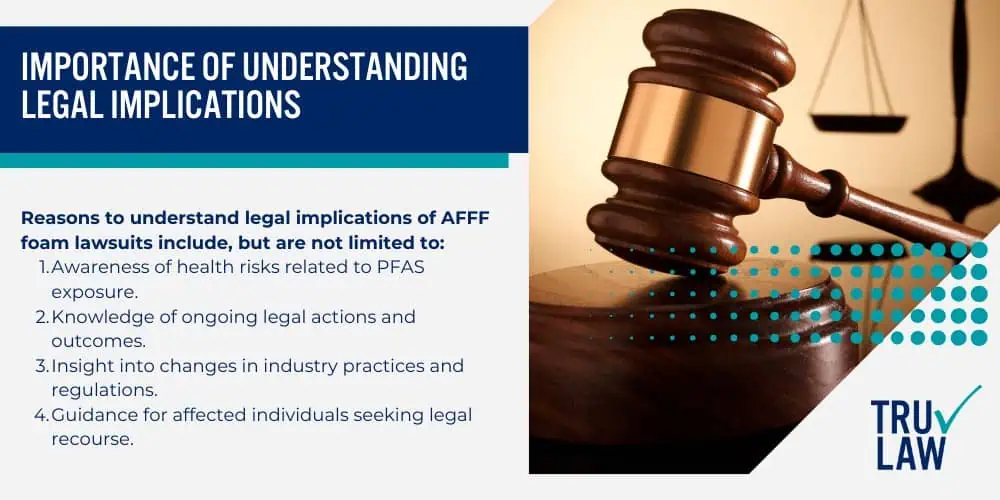
Reasons to understand legal implications of AFFF foam lawsuits include, but are not limited to:
- Awareness of health risks related to PFAS exposure.
- Knowledge of ongoing legal actions and outcomes.
- Insight into changes in industry practices and regulations.
- Guidance for affected individuals seeking legal recourse.
Key Legal Issues in AFFF Foam Cancer Lawsuits
Key legal issues in AFFF foam cancer lawsuits include proving that exposure to AFFF foam caused cancer and addressing regulatory and compliance problems.
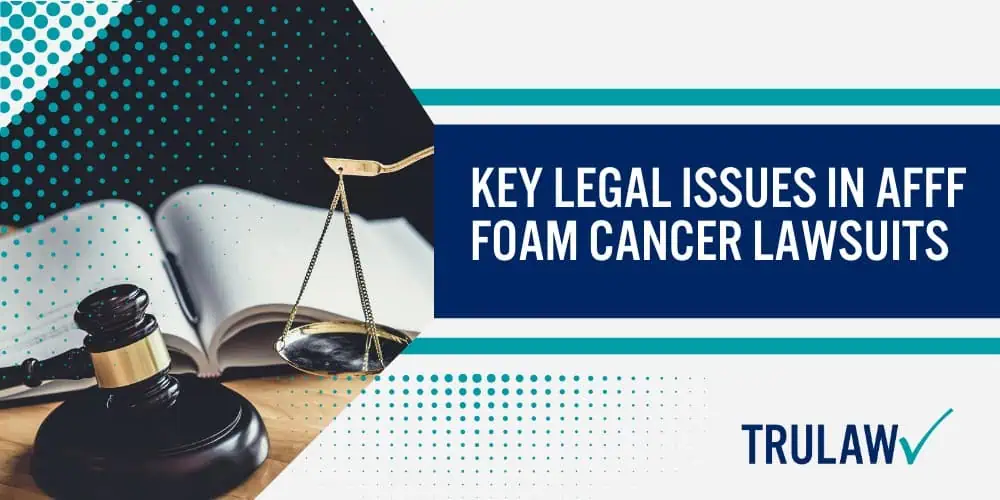
Understanding these aspects is vital for affected individuals and legal professionals.
Proving Causation: Linking AFFF Foam to Cancer
Proving causation is a major challenge.
Plaintiffs must show that AFFF foam exposure directly led to their cancer.
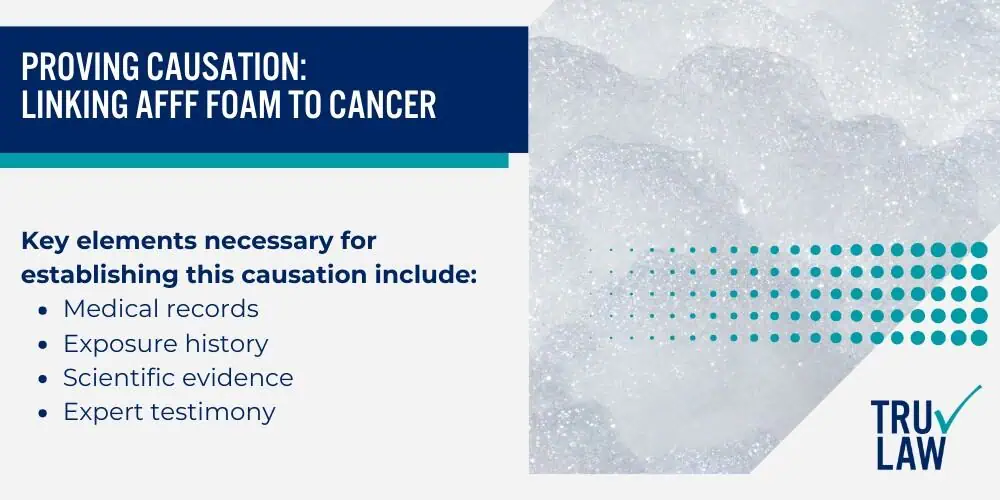
Key elements necessary for establishing this causation include:
- Medical records: Detailed medical history and documentation of cancer diagnosis.
- Exposure history: Proof of regular contact with AFFF foam, especially for firefighters, military personnel, and airport workers.
- Scientific evidence: Studies linking PFAS in AFFF to specific cancers like kidney, liver, and testicular cancers.
- Expert testimony: Specialists in toxicology and epidemiology can substantiate the causation claim.
The complexity of linking AFFF foam to cancer makes these lawsuits demanding. Legal teams often rely on epidemiological studies and expert analysis to build a strong case.
Regulatory and Compliance Issues in AFFF Litigation
Regulatory and compliance issues play a crucial role in AFFF litigation.
The Environmental Protection Agency (EPA) and other bodies have guidelines on PFAS usage.
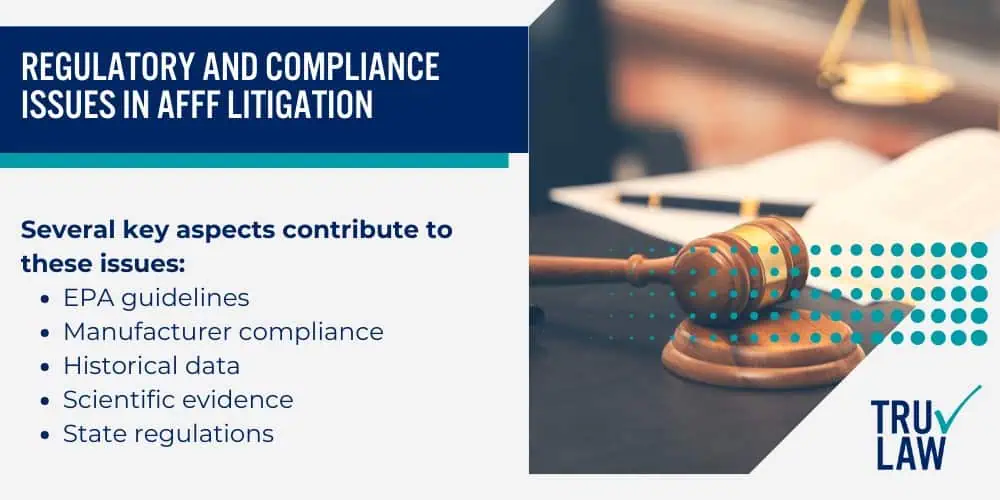
Several key aspects contribute to these issues:
- EPA guidelines: Monitoring and limits on PFAS levels in water and soil help establish environmental contamination.
- Manufacturer compliance: Companies like 3M and DuPont must follow safety regulations. Violations can strengthen the plaintiff’s case.
- Historical data: Evidence that manufacturers knew about PFAS risks but failed to act.
- State regulations: Variations in PFAS limits and enforcement between states affect litigation.
These issues also involve the AFFF Firefighting Foam MDL (Multi-District Litigation), which centralizes many lawsuits around AFFF foam to streamline the legal process.
Factors Influencing AFFF Foam Cancer Lawsuit Outcomes
Several key aspects can affect the outcomes of AFFF firefighting foam cancer lawsuits, including the severity of health impacts such as cancer types and the legal jurisdiction where the case is filed.
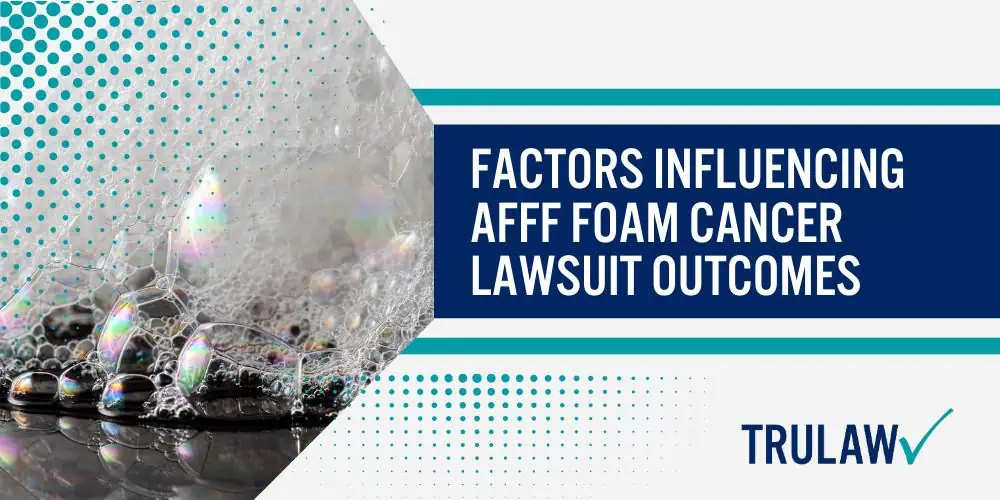
Health Impacts and Their Role in Payouts
The type and severity of health impacts are critical factors.
Certain cancers like kidney cancer, prostate cancer, and testicular cancer are often linked to AFFF exposure.
These conditions can lead to significant lawsuits because they are serious and potentially life-threatening.
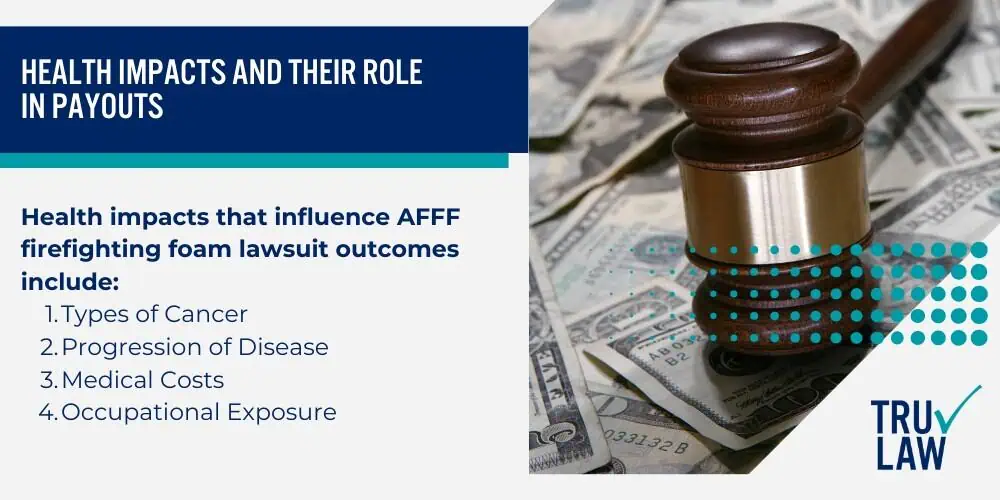
Health impacts that influence AFFF firefighting foam lawsuit outcomes include:
- Types of Cancer: Prostate and thyroid cancer are common claims.
- Progression of Disease: Advanced stages may lead to higher settlements.
- Medical Costs: High treatment costs can increase compensation.
- Occupational Exposure: Firefighters and military personnel may receive different payouts based on exposure levels.
Testimony from medical experts can also play a role in determining payouts.
The link between exposure to PFAS (found in AFFF) and specific cancers like thyroid disease and testicular cancer must be well-documented.
Jurisdictional Differences and Legal Precedents
The outcome of AFFF foam cancer lawsuits can vary significantly based on legal jurisdiction.
Different states handle these cases differently, with some having more favorable conditions for plaintiffs.
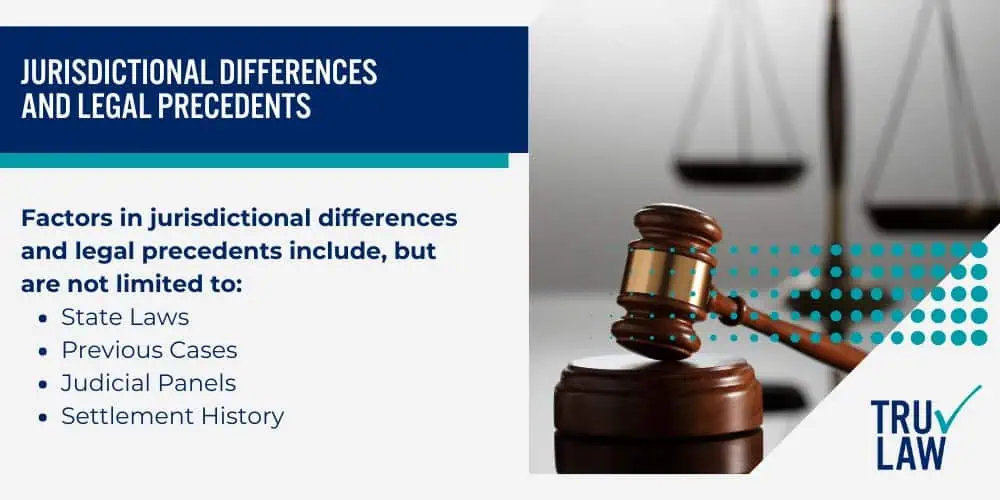
Factors in jurisdictional differences and legal precedents include, but are not limited to:
- State Laws: Some states have stricter regulations on PFAS.
- Previous Cases: Legal precedents can heavily influence new lawsuits.
- Judicial Panels: Panels like the U.S. Judicial Panel on Multidistrict Litigation can centralize cases in specific courts, such as South Carolina.
- Settlement History: States with high settlement awards often see more lawsuits.
Case Studies: AFFF Foam Cancer Lawsuits
Lawsuits related to AFFF firefighting foam often involve debates over product liability, negligence, and environmental harm.
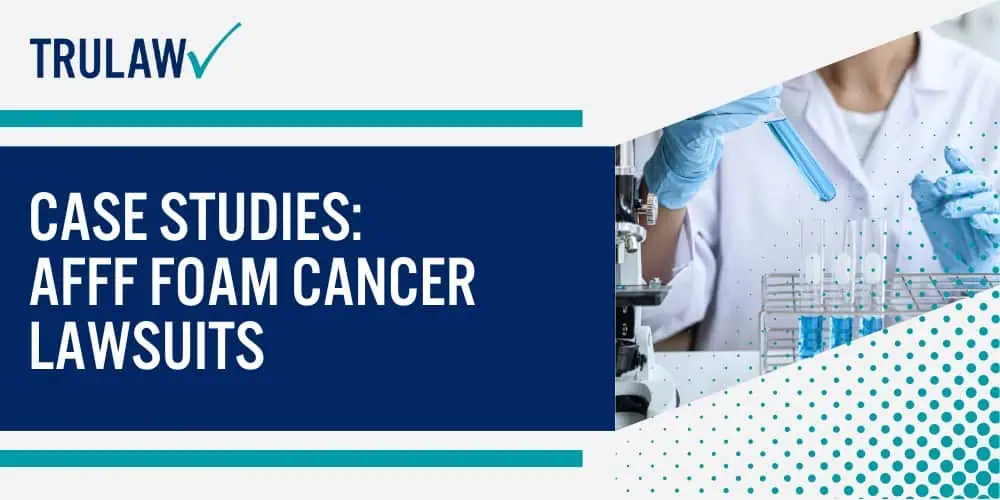
Legal battles have resulted in significant settlements and have sparked numerous class actions and individual lawsuits.
Notable Settlements and Their Legal Implications
Several AFFF firefighting foam cases have led to substantial settlements.
These cases highlight legal implications for manufacturers like DuPont and 3M.
Key examples of notable settlements in AFFF firefighting foam cases include, but are not limited to:
- Historic Settlements: Some cases have resulted in multi-million dollar agreements.
- PFAS Contamination Claims: Plaintiffs usually claim health damages due to PFAS in the foam.
- Impact on Corporations: Legal outcomes affect future company practices and regulations.
- Health Consequences: Settlements often account for medical expenses and long-term health monitoring.
These settlements point to the liability of foam producers and potential changes in safety standards for firefighting materials.
Comparing Class Action vs. Individual AFFF Foam Lawsuits
Firefighting foam class action lawsuits allow multiple plaintiffs to combine claims.
This approach has both advantages and challenges.
Here are some key benefits of class action lawsuits:
- Strength in Numbers: Class actions can put greater pressure on defendants like chemical manufacturers.
- Uniformity: These cases generally result in more predictable outcomes.
- Cost-Effective: Legal costs are shared among plaintiffs.
In contrast, individual AFFF foam lawsuits might offer personalized compensation but can be more demanding for the plaintiff.
- Personal Injury Focus: Individual lawsuits address specific health concerns of one plaintiff.
- Potential for Larger Awards: Plaintiffs may receive higher compensations tailored to their unique situations.
- Longer Legal Process: Individual cases often take more time to resolve.
Understanding these different approaches helps impacted individuals decide how to pursue legal action.
How to Determine Eligibility for an AFFF Foam Cancer Lawsuit
Individuals may be eligible to file an AFFF foam cancer lawsuit if they have developed cancer due to exposure to hazardous chemicals in firefighting foam.
Understanding the key criteria and the necessary steps can help in taking legal action.
Criteria for Filing an AFFF Foam Cancer Lawsuit
Individuals who believe they have been affected by AFFF foam must meet specific conditions to pursue legal action.
These criteria ensure that only those with legitimate claims move forward.
To determine eligibility, certain criteria must be met:
- Exposure to AFFF: The individual must have been regularly exposed to aqueous film-forming foam (AFFF) containing PFAS, typically in settings like military bases, airports, or firefighting departments.
- Diagnosis of Cancer: The individual must have developed cancer, such as kidney, bladder, or testicular cancer, which is linked to the toxic chemicals in AFFF.
- Work History: Proof of occupational exposure, like employment records from firefighting agencies or military service, is needed.
- Duration of Exposure: A sufficient period of frequent exposure, usually years, must be documented.
- Medical Records: Comprehensive medical documentation demonstrating the cancer diagnosis and potential linkage to AFFF exposure is necessary.
Steps to Take When Considering Legal Action
Taking legal action can be challenging, but being prepared can make a significant difference.
When considering legal action for an AFFF foam cancer lawsuit, follow these steps:
- Consultation with a Lawyer: Speak with an attorney specialized in AFFF lawsuits to assess your case and eligibility.
- Documenting Exposure: Gather detailed records of your exposure to AFFF, including work history and duration.
- Medical Evaluation: Obtain a thorough medical evaluation linking your cancer to AFFF exposure.
- Filing a Claim: File an AFFF lawsuit, either individually or as part of an AFFF class action lawsuit.
- Legal Procedures: Follow your lawyer’s advice on the legal procedures and deadlines.
- Staying Informed: Stay updated on the progress of your case and any new developments in AFFF litigation.
Financial Implications of AFFF Foam Cancer Lawsuit Settlements
Settlements from the AFFF foam cancer lawsuits carry significant financial repercussions for both individuals and corporations involved.
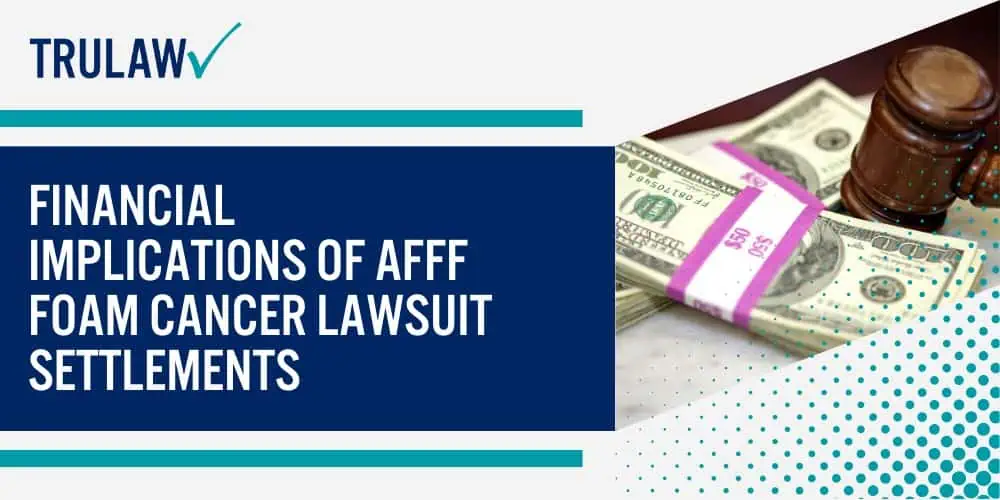
This affects many areas, from compensatory damages to the long-term financial stability of those impacted.
Breakdown of Compensation Categories in AFFF Settlements
Compensation in AFFF settlements typically covers several categories.
Economic damages include medical expenses, lost wages, and rehabilitation costs.
Non-economic damages may involve pain and suffering or loss of enjoyment of life.
Finally, punitive damages punish the defendants and serve as a deterrent against future negligence.
Common categories of compensation in AFFF settlements include, but are not limited to:
- Medical Expenses: Costs for treatments, surgeries, medications, and ongoing care.
- Lost Wages: Income lost due to inability to work.
- Rehabilitation Costs: Physical therapy, psychological counseling, and other recovery support.
- Pain and Suffering: Non-quantifiable emotional and physical suffering.
- Loss of Enjoyment of Life: Impact on the individual’s quality of life.
- Punitive Damages: Additional fines to penalize responsible companies.
These categories ensure comprehensive coverage of the financial strains experienced by affected individuals.
Long-Term Financial Impacts on Affected Individuals
Settlements provide immediate relief but the long-term financial impact on affected individuals can be profound.
Long-term medical costs are a major concern.
Continuous treatments and monitoring for cancer survivors add significant expense over time.
Loss of income potential is another factor where individuals can face reduced earning capacity due to ongoing health issues.
Key long-term financial impacts on affected individuals include, but are not limited to:
- Continuous Medical Expenses: Ongoing costs for routine check-ups, medications, and potential relapses.
- Reduced Earning Capacity: Inability to return to previous employment levels or career shifts due to health limitations.
- Financial Stress: The strain of managing debts incurred from treatments or loss of job.
- Emotional Toll: Financial insecurity leads to increased stress and mental health challenges.
Addressing these consequences requires careful planning and resources to ensure financial stability for those affected.
Legal Representation and Resources for AFFF Foam Lawsuits
Experienced AFFF firefighting foam lawyers, resources, and support can make a significant difference in pursuing AFFF foam cancer lawsuits.
It is important to find the right legal team and tap into available resources for the best possible outcome.
Finding the Right Lawyer for an AFFF Foam Cancer Case
Finding the right lawyer is critical.
Experienced firefighting foam lawyers understand the nuances of these cases and can guide plaintiffs through the legal process.
Here are some steps to consider:
- Research Specialized Law Firms: Look for law firms that specialize in environmental law and toxic torts.
- Check Track Records: Verify the fight record of potential firefighting foam attorneys in similar cases.
- Consultation Meetings: Schedule consultations to discuss your case and assess their expertise and approach.
- Ask for Recommendations: Seek testimonials or reviews from other plaintiffs who have pursued similar lawsuits.
- Understand Fee Structures: Clarify the fee structure, often contingent-based, ensuring no upfront costs.
Resources and Support for AFFF Firefighting Foam Lawsuit Plaintiffs
Plaintiffs in firefighting foam lawsuits have access to various resources to help them through the legal process.
Important resources for AFFF firefighting foam lawsuit plaintiffs include, but are not limited to:
- Legal Aid Organizations: Agencies that offer pro-bono legal help to those who qualify.
- Support Groups: Networks of other affected individuals providing emotional and logistical support.
- Information Repositories: Websites or libraries with historical data on PFAS contamination and AFFF use.
- Medical Documentation Tools: Assistance in compiling necessary medical records and evidence.
- Legal Clinics: Free consultations or workshops on understanding your rights and legal procedures.
- Community Resources: Local community organizations that may offer additional help for affected families.
By leveraging these resources and choosing the right AFFF lawyers, plaintiffs can build a stronger case and improve their chances of achieving a favorable verdict.
Future Outlook on AFFF Foam Cancer Lawsuits and Regulations
The landscape of Aqueous Film Forming Foam (AFFF) litigation and regulations is evolving rapidly.
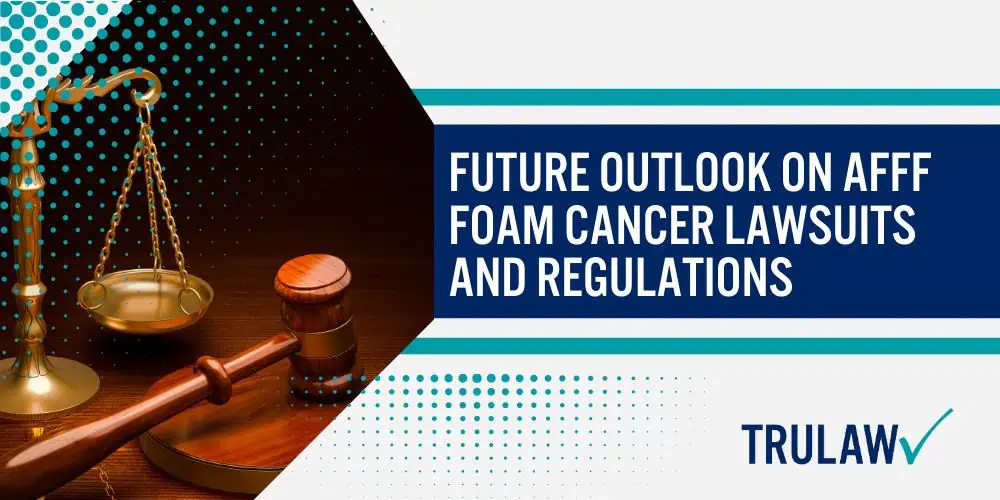
Legal actions and policy changes are expected to impact manufacturers, users, and individuals diagnosed with cancer related to AFFF exposure.
Expected Trends in AFFF Foam Litigation and Payouts
Expected Trends in AFFF Foam Litigation and Payouts
Lawsuits over AFFF foam and its associations with cancer are on the rise.
As more individuals link their cancer diagnoses to this chemical, legal battles are intensifying.
Courts are seeing an uptick in cases involving firefighting foam cancer.
Key trends in AFFF foam litigation and payouts include, but are not limited to:
- Increasing Lawsuits: More firefighters, military personnel, and other first responders are filing claims.
- Higher Payouts: Settlements and damages awarded to plaintiffs are growing.
- Class Action Suits: Many lawsuits are merging into large class action cases.
- Legal Precedents: Early cases are setting benchmarks for future litigation.
- Plaintiff Support: More resources are available to help victims file and win lawsuits.
As awareness spreads, we can expect these trends to strengthen, resulting in significant financial liabilities for manufacturers and offensive strategies by defense teams.
Potential Changes in Regulations and Their Impact on Lawsuits
Regulatory changes are on the horizon as the dangers of AFFF foam become clearer.
Government agencies and lawmakers are scrutinizing PFAS (per- and polyfluoroalkyl substances) found in AFFF, known as “forever chemicals”.
Key regulatory changes in regulations may include:
- Stricter Safety Standards: Tighter controls on the use of AFFF in various industries.
- Bans and Restrictions: Some regions may ban AFFF altogether.
- Product Replacements: Development and mandatory use of safer alternatives.
- Health Monitoring: Increased health surveillance for those exposed to AFFF.
- Enhanced Reporting: Fines and penalties for non-compliance in reporting AFFF usage and disposal.
Potential impacts of these regulatory changes include, but are not limited to:
- Increased Compliance Costs: Higher costs for companies to comply with new regulations.
- More Lawsuits: Stricter laws may result in easier paths to proving negligence.
- Greater Transparency: Enhanced record-keeping may unearth more cases of contamination.
Tru Law: Maximizing Your AFFF Foam Cancer Lawsuit Payout
Working with Tru Law can greatly enhance your chances of receiving a fair payout in your AFFF lawsuit.
Their experience and methods are designed to manage various aspects of the lawsuit effectively.
How Tru Law Can Help You File an AFFF Lawsuit
Tru Law specializes in dealing with AFFF cancer lawsuits and related personal injury claims.
Our extensive legal network will identify key points of contamination and exposure to maximize the compensation for your damages.
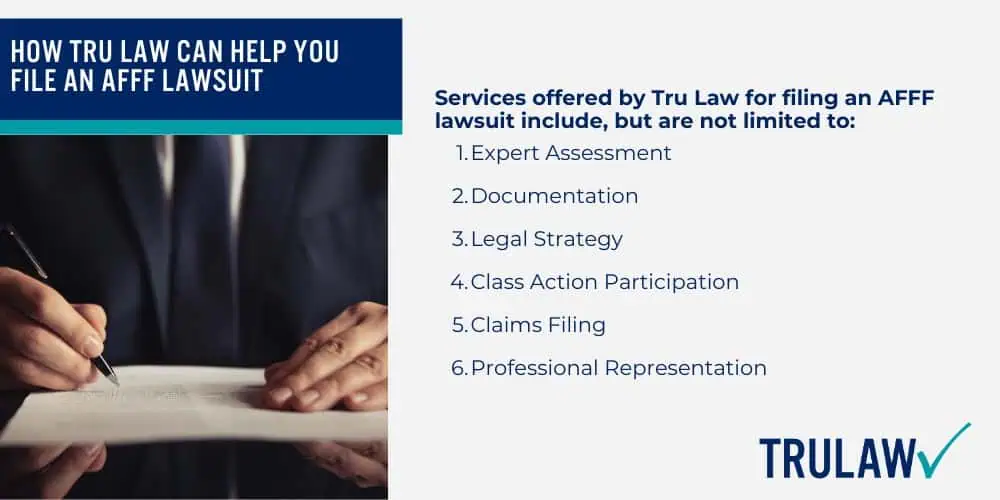
Services offered by Tru Law for filing an AFFF lawsuit include, but are not limited to:
- Expert Assessment: They perform a detailed examination of your exposure to AFFF and associated PFAS contamination.
- Documentation: Help in gathering essential records like medical reports, employment history, and exposure details.
- Legal Strategy: They help you develop a strong legal approach to hold AFFF manufacturers accountable.
- Class Action Participation: They also assist in joining or understanding potential AFFF class action lawsuits against manufacturers.
- Claims Filing: They guide you through the Firefighter Cancer Registry Act and other relevant legislative protections.
- Professional Representation: They provide access to seasoned firefighting foam cancer lawyers to represent your case in court.
AFFF Lawsuit Frequently Asked Questions
-
What types of cancer are associated with AFFF exposure?
Exposure to AFFF foam is often linked to cancers such as kidney cancer, testicular cancer, and bladder cancer.
These links have been highlighted in various health studies.
-
Are there specific eligibility requirements for participation in the AFFF lawsuit?
To join the AFFF lawsuit, individuals generally need to show they were exposed to AFFF foam and subsequently diagnosed with related cancer.
Proof of exposure and medical records are critical.
-
What are the potential compensation amounts for claimants in the AFFF lawsuit?
Compensation amounts can vary depending on the severity of the illness and individual circumstances.
Settlements may cover medical expenses, lost wages, and pain and suffering.
-
How are the settlement tiers structured in the AFFF lawsuit?
Settlement tiers in the AFFF lawsuit may be structured based on the type and severity of cancer, length of exposure, and impact on quality of life.
Different tiers ensure fair compensation relative to each case.
-
What is the anticipated timeline for the AFFF lawsuit resolution?
The timeline for resolving the AFFF lawsuit could span several years.
Factors include the complexity of cases, the number of claimants, and court schedules.
-
Which law firms specialize in representing AFFF-related cancer cases?
Several law firms specialize in AFFF-related cancer cases.
These include national firms and those with specific experience in environmental litigation.
Seek firms with a strong track record in similar cases.

Managing Attorney & Owner
With over 25 years of legal experience, Jessica Paluch-Hoerman is an Illinois lawyer, a CPA, and a mother of three. She spent the first decade of her career working as an international tax attorney at Deloitte.
In 2009, Jessie co-founded her own law firm with her husband – which has scaled to over 30 employees since its conception.
In 2016, Jessie founded TruLaw, which allows her to collaborate with attorneys and legal experts across the United States on a daily basis. This hypervaluable network of experts is what enables her to share the most reliable, accurate, and up-to-date legal information with our readers!
Additional AFFF Lawsuit resources on our website:
Here, at TruLaw, we’re committed to helping victims get the justice they deserve.
Alongside our partner law firms, we have successfully collected over $3 Billion in verdicts and settlements on behalf of injured individuals.
Would you like our help?
At TruLaw, we fiercely combat corporations that endanger individuals’ well-being. If you’ve suffered injuries and believe these well-funded entities should be held accountable, we’re here for you.
With TruLaw, you gain access to successful and seasoned lawyers who maximize your chances of success. Our lawyers invest in you—they do not receive a dime until your lawsuit reaches a successful resolution!
AFFF Lawsuit claims are being filed against manufacturers of aqueous film-forming foam (AFFF), commonly used in firefighting.
Claims allege that companies such as 3M, DuPont, and Tyco Fire Products failed to adequately warn users about the potential dangers of AFFF exposure — including increased risks of various cancers and diseases.
Depo Provera Lawsuit claims are being filed by individuals who allege they developed meningioma (a type of brain tumor) after receiving Depo-Provera birth control injections.
A 2024 study found that women using Depo-Provera for at least 1 year are five times more likely to develop meningioma brain tumors compared to those not using the drug.
Suboxone Tooth Decay Lawsuit claims are being filed against Indivior, the manufacturer of Suboxone, a medication used to treat opioid addiction.
Claims allege that Indivior failed to adequately warn users about the potential dangers of severe tooth decay and dental injuries associated with Suboxone’s sublingual film version.
Social Media Harm Lawsuits are being filed against social media companies for allegedly causing mental health issues in children and teens.
Claims allege that companies like Meta, Google, ByteDance, and Snap designed addictive platforms that led to anxiety, depression, and other mental health issues without adequately warning users or parents.
Transvaginal Mesh Lawsuits are being filed against manufacturers of transvaginal mesh products used to treat pelvic organ prolapse (POP) and stress urinary incontinence (SUI).
Claims allege that companies like Ethicon, C.R. Bard, and Boston Scientific failed to adequately warn about potential dangers — including erosion, pain, and infection.
Bair Hugger Warming Blanket Lawsuits involve claims against 3M — alleging their surgical warming blankets caused severe infections and complications (particularly in hip and knee replacement surgeries).
Plaintiffs claim 3M failed to warn about potential risks — despite knowing about increased risk of deep joint infections since 2011.
Baby Formula NEC Lawsuit claims are being filed against manufacturers of cow’s milk-based baby formula products.
Claims allege that companies like Abbott Laboratories (Similac) and Mead Johnson & Company (Enfamil) failed to warn about the increased risk of necrotizing enterocolitis (NEC) in premature infants.
Here, at TruLaw, we’re committed to helping victims get the justice they deserve.
Alongside our partner law firms, we have successfully collected over $3 Billion in verdicts and settlements on behalf of injured individuals.
Would you like our help?
